
End of an era: city's last cotton mill to close
Some 300 workers face an uncertain future as success story of the manufacturing boom decides HK has become too expensive to operate in
The Tai Hing Cotton Mill was one of the success stories of Hong Kong's manufacturing boom in the 1960s and 1970s.

Unionist Leung Yiu-chung, who was the textiles and clothing functional constituency lawmaker from 1995 to 1997, said he expected it to be very difficult for the some 300 cotton mill workers to find new jobs because many were old and their skills were not needed in modern Hong Kong.
"It was a difficult decision. I felt I had no choice," said the company's executive director Clement Chen Cheng-jen, a former chairman of the Federation of Hong Kong Industries, who did not allow the to enter the factory to film or interview workers.
"Operation costs are too high for our plant to stay here. We don't have to pay rent since we operate on our own premises, but costs on all fronts have been rising. Energy costs particularly have been a big burden because of the increasing mechanisation of the production mode."
The firm was founded by his father, Chen Yuan-chu, in 1957. Its office will remain in the city.
Chen said some workers would be transferred to other posts within the company, but he accepted others would be made redundant or retire.
Textile and clothes manufacturing was an economic pillar of Hong Kong in the 1970s and 1980s. In 1979, the sector employed more than 378,000 people, accounting for 18 per cent of the total working population.
Annual production in 1979 was valued at HK$24 billion, making up 43 per cent of the city's total exports. By 2012, the sector employed 13,500 people and made goods valued at HK$3.4 billion - less than 6 per cent of total exports that year.
Chen himself has spent his career of over 30 years at the plant, starting as an intern and including a stint in almost every position on his way to management.
Recently the industry has faced a lack of new blood. "Very few young people now are willing to enter the trade. Many skilled jobs in Hong Kong face the same problem, such as lift maintenance. Moreover, with an unemployment rate as low as 3.3 per cent … it is difficult for us to hire."
Orders have also been drying up, Chen said. "I only see our competitiveness in Hong Kong weakening." The company is looking for a Southeast Asian location where government policies are "industry-friendly", with few restrictions on imports and exports, he said. The mainland is not an option as operating costs in the traditional manufacturing sector there are also surging. While the Hong Kong government already has a number of schemes to assist small and medium-sized enterprises, Chen felt it was inevitable for the city's economy to lean towards endeavours that produced higher profits. And an absence of factories does not mean Hong Kong no longer has industries, he said.
"One does not necessarily have to keep the production line here, as long as the company is based in Hong Kong."
Liberal Party legislator Vincent Fang Kang, a veteran of the garment business with factories in Zhongshan , shared Chen's view that Hong Kong was no longer suitable for cotton mill operations after weaving and dyeing factories moved to the mainland years ago.
"It has become very costly to keep a spinning factory here considering the transport costs … Instead of manufacturing, the competitive edge of Hong Kong in the textile and garment sector is now in design and logistics," he said.
Many factories formerly in mainland China have been moved to Vietnam, where production costs are lower, Fang said. Last month, Hong Kong textile manufacturers signed a deal to build an industrial park in Yangon, Myanmar, with a view to cutting production costs by half.
